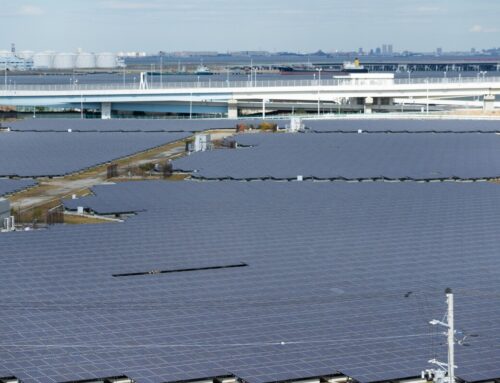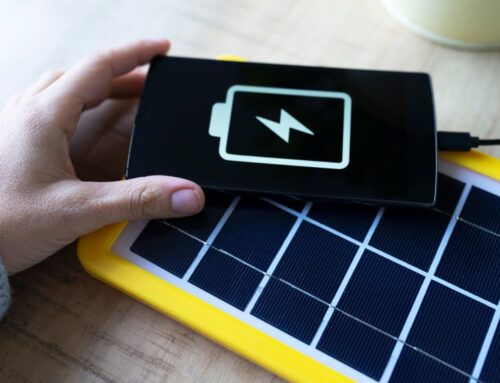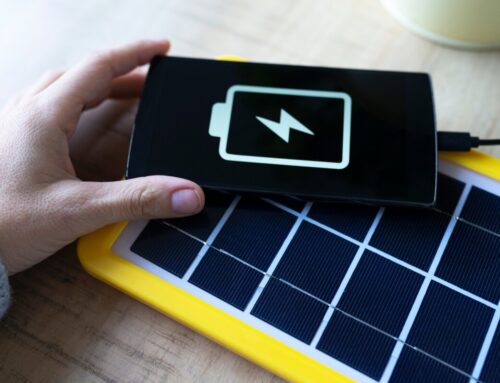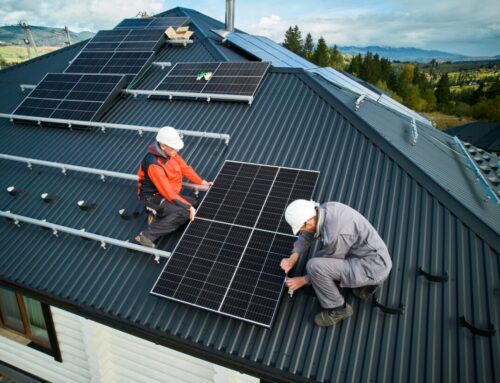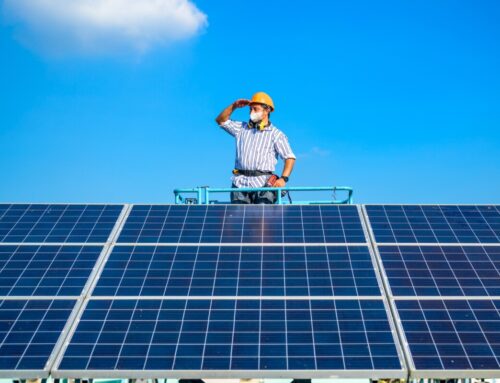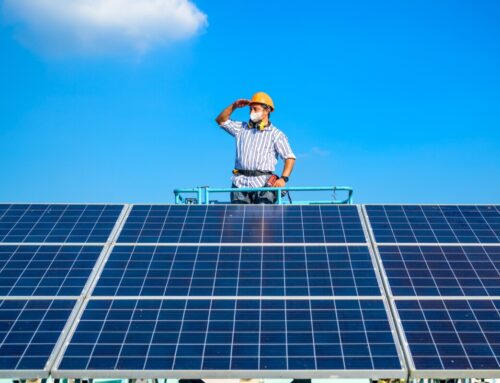Solar Power Plants: Clean Energy Generation
Understanding the Basics: What is a Solar Power Plant?
In today’s world, where the demand for clean and sustainable energy is ever-increasing, understanding how a solar power plant generates clean energy is crucial. Solar power plants harness the sun’s energy, converting it into electricity without emitting harmful pollutants. This process not only helps reduce our carbon footprint but also provides a renewable energy source that can power homes, businesses, and even entire communities.
A solar power plant primarily uses photovoltaic (PV) panels or mirrors to capture sunlight. These panels contain solar cells made of semiconductor materials, usually silicon, which absorb sunlight and create an electric field across layers. This process, known as the photovoltaic effect, generates direct current (DC) electricity.
- Photovoltaic Panels: These are the most common components, converting sunlight directly into electricity.
- Inverters: Convert DC electricity into alternating current (AC), which is used by most household appliances.
- Grid Connection: Excess electricity can be fed back into the grid, providing energy to other users and often earning credits for the plant. By utilizing these components, solar power plants efficiently transform sunlight into usable energy, making them a cornerstone of sustainable energy solutions. Transitioning to solar energy not only supports environmental goals but also promotes energy independence and resilience.
Harnessing the Sun: How Solar Panels Capture Energy
In a world increasingly focused on sustainability, understanding how a solar power plant generates clean energy is crucial. Solar power plants harness the sun’s abundant energy, converting it into electricity without emitting harmful pollutants. This process not only reduces our carbon footprint but also offers a renewable energy source that can be replenished naturally. By capturing sunlight and transforming it into usable power, solar power plants play a pivotal role in the global shift towards greener energy solutions. Solar power plants utilize photovoltaic (PV) panels to capture sunlight and convert it into electricity.
These panels are made up of numerous solar cells, which are composed of semiconductor materials like silicon. When sunlight hits these cells, it excites electrons, creating an electric current.
Key Steps in Energy Conversion
- Absorption of Sunlight: Solar panels absorb photons from sunlight.
- Electron Excitation: Photons energize electrons in the solar cells.
- Electric Current Generation: Energized electrons flow, creating direct current (DC).
- Inverter Conversion: Inverters convert DC into alternating current (AC), which powers homes and businesses. By following these steps, solar power plants efficiently transform sunlight into clean, renewable energy, contributing significantly to a sustainable future.
From Sunlight to Electricity: The Conversion Process Explained
Harnessing the power of the sun, a solar power plant stands as a beacon of clean energy generation, offering a sustainable alternative to fossil fuels. But how does a solar power plant generate clean energy? The process is both fascinating and efficient, converting sunlight into electricity that powers homes and businesses. Understanding this conversion process not only highlights the innovation behind solar technology but also underscores its importance in reducing carbon footprints and combating climate change.
Capturing Sunlight
At the heart of a solar power plant are photovoltaic (PV) cells, which are responsible for capturing sunlight. These cells, typically made from silicon, absorb photons from sunlight, initiating the conversion process.
Read Also: Explore How a Solar Electricity Plant Powers the Future!
Generating Electricity
Once the sunlight is absorbed, the PV cells generate an electric current through the photovoltaic effect. This direct current (DC) is then transformed into alternating current (AC) by inverters, making it suitable for use in the electrical grid.
Distribution and Usage
Finally, the electricity is distributed through power lines to homes and businesses, providing a clean, renewable source of energy. This seamless process not only reduces reliance on non-renewable resources but also promotes a greener, more sustainable future.

Curious about solar? Let us help you discover how solar energy can revolutionize your home and save you money. Request Your Free Solar Estimate at SOLAR ENERGY
The Role of Inverters: Transforming DC to AC Power
Harnessing the sun’s energy through a solar power plant is a remarkable way to generate clean energy, significantly reducing our reliance on fossil fuels. At the heart of this process is the transformation of sunlight into electricity, which involves several key components working in harmony. One crucial element in this system is the inverter, which plays a pivotal role in converting the direct current (DC) generated by solar panels into alternating current (AC) power that can be used by homes and businesses.
Understanding the Conversion
Process Solar panels capture sunlight and convert it into DC electricity. However, most household appliances and the electrical grid operate on AC power. This is where inverters come into play. They efficiently convert the DC electricity into AC, ensuring that the energy produced by the solar power plant is compatible with everyday electrical devices. This conversion process is vital for integrating solar energy into the existing power infrastructure, making it accessible and usable for consumers.
Read Also: Unlock the Science: How Solar Thermal Energy Works!
Types of Inverters and Their Benefits
There are several types of inverters used in solar power plants, each with unique advantages. String inverters are cost-effective and suitable for installations with consistent sunlight exposure.
Microinverters, on the other hand, are ideal for systems with shading issues, as they optimize the output of each solar panel individually. Additionally, power optimizers enhance the performance of string inverters by maximizing the energy harvest from each panel. By choosing the right type of inverter, solar power plants can optimize efficiency and reliability, further promoting the adoption of clean energy.
Environmental Impact: Why Solar Power Plants are a Clean Energy Source
Solar power plants are pivotal in the global shift towards sustainable energy, harnessing the sun’s abundant energy to generate electricity without emitting harmful pollutants. This clean energy source is crucial in reducing our carbon footprint and combating climate change. By understanding how a solar power plant generates clean energy, we can appreciate its environmental benefits and the role it plays in a greener future.
Harnessing Solar Energy
Solar power plants capture sunlight using photovoltaic (PV) panels or mirrors that concentrate solar radiation. These systems convert sunlight into electricity through the photovoltaic effect or by heating a fluid to produce steam that drives a turbine. This process is emission-free, making solar power plants a clean energy source.
Benefits of Solar Power
- Reduces Carbon Emissions: Unlike fossil fuels, solar power plants do not release carbon dioxide or other greenhouse gases.
- Sustainable and Renewable: Solar energy is inexhaustible, ensuring a long-term energy solution.
- Minimal Water Usage: Solar power generation requires little to no water, preserving this vital resource.
Innovations in Solar Technology: What’s Next for Solar Power Plants?
Harnessing the sun’s energy is not just a futuristic dream; it’s a present-day reality that is reshaping how we think about power. A solar power plant is at the forefront of this transformation, converting sunlight into clean, renewable energy. This process is crucial in reducing our reliance on fossil fuels and minimizing carbon emissions, making solar power plants a cornerstone in the fight against climate change. But how exactly does a solar power plant generate this clean energy? Let’s delve into the innovations driving this technology forward.
Photovoltaic Cells: The Heart of Solar Power
Photovoltaic (PV) cells are the primary components that allow a solar power plant to convert sunlight into electricity. These cells, made from semiconductor materials like silicon, absorb photons from sunlight, knocking electrons loose and creating an electric current. This process is both efficient and environmentally friendly, as it produces no emissions during operation.
Concentrated Solar Power: Amplifying Efficiency
Another innovative approach is concentrated solar power (CSP), which uses mirrors or lenses to focus a large area of sunlight onto a small area. The concentrated light is converted into heat, which drives a heat engine connected to an electrical power generator. This method can store energy for use when the sun isn’t shining, enhancing the reliability and efficiency of solar power plants.
How SolarEnergy Can Help You Embrace Solar Energy Solutions
Solar power plants are at the forefront of the clean energy revolution, offering a sustainable solution to our growing energy needs. Understanding how a solar power plant generates clean energy is crucial for anyone considering a shift to renewable sources. These plants harness the sun’s energy, converting it into electricity without emitting harmful pollutants, making them an eco-friendly alternative to fossil fuels. As we face increasing environmental challenges, embracing solar energy becomes not just an option but a necessity for a greener future.
Benefits of Solar Power Plants
- Sustainable Energy Source: Solar power plants utilize the sun’s energy, which is abundant and renewable.
- Reduced Carbon Footprint: By generating electricity without burning fossil fuels, they significantly lower greenhouse gas emissions.
- Cost Savings: Over time, solar energy can reduce electricity bills and offer protection against rising energy costs. You can explore these benefits and more, ensuring a seamless transition to clean energy. Our team is dedicated to helping you harness the power of the sun, making solar energy accessible and advantageous for everyone.
Don’t wait to go solar! Thousands of homeowners are saving—join them and start reaping the benefits.
Book Your Free Consultation at SOLAR ENERGY
Explore additional solar solutions at NEW SOLAR QUOTES and discover how it can benefit your home!


